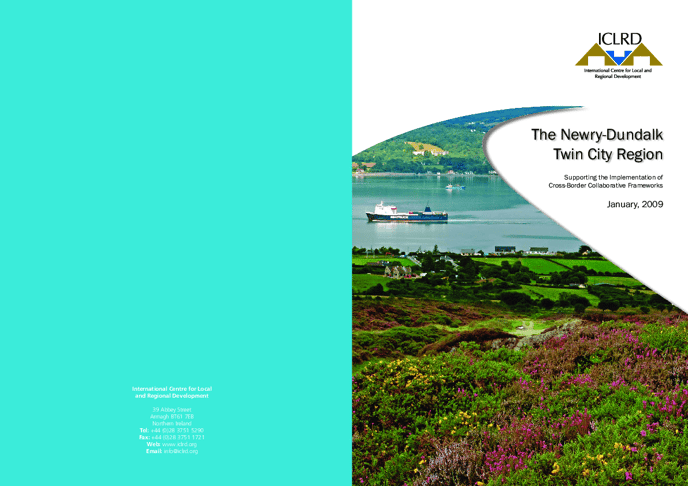The Newry-Dundalk Twin City Region: Supporting the Implementation of Cross-Border Collaborative Frameworks
Published: January 2009
Executive summary
Policy Context
This study brings together recent and current research on how to realise the benefits of cross-border collaboration in the Newry-Dundalk sub-region through integrated planning and development strategies.
Newry-Dundalk Sub-Region Steering Group
Policy Research and Proposals
- A non-statutory approach to an integrated spatial planning and development framework focused on the benefits resulting from enhanced co-operation between Newry and Dundalk;
- Actions to facilitate promotion, tourism, skills training, education, innovation, business development and the knowledge economy;
- Joint analysis and action by stakeholders in areas such as sustainable development, cultural heritage, trade and investment, environmental management and regeneration; and
- Spatial planning data and research relating to the key drivers influencing development patterns and trends.
- Coordinated approach to sustainable economic development;
- Joint actions to implement common objectives;
- Creation of common inter-jurisdictional databases;
- Alignment of legal and institutional frameworks.
- Economic competitiveness;
- Sustainable development;
- Improved community cohesion;
- Preservation of the natural and cultural heritage;
- Increased efficiency resulting from the coordination of infrastructure investment; and
- Up-skilling for an economically productive workforce.
- A Dundalk/Newry Centre of Excellence to create a sustainable energy community linked to the work of Sustainable Energy Ireland (SEI) and EU Concerto funding which is positioning Dundalk 2020 as an exemplar for the island as a whole;
- A Newry-Dundalk cross-border international services zone linked to international financial and other related services that will create additional tertiary employment;
- Geo-tourism and the management of a shared landscape and natural heritage to safeguard the geological assets and natural resources of the Mournes, Cooley, Slieve Gullion, and Carlingford Lough, and develop the tourism potential of the sub-region; and
- A coordinated regeneration strategy for older areas in Newry and Dundalk, to promote the distinctiveness of the two cities, further the complementarities of their respective urban functions and improve their liveability.
Next Steps
- Identifying legal and administrative procedures on each side of the border that may hinder co-operation;
- Quantifying the potential for synergies for investment;
- Proposing solutions to institutional obstacles; and
- Promoting and branding the unique identity of the sub-regions.
1. Continue and enhance the Joint Senior Management Group, composed of the County / Town Managers and Council Executives and their senior department heads to develop areas selected for future co-operation into a sequence of interventions to implement commonly agreed strategic projects. It will also ensure the necessary liaison with central government agencies and cross-border bodies.
2. Create a Twin City Region Advisory Group modelled on the Steering Committee and composed of representatives of the Newry-Mourne District, Louth County and Dundalk Town Councils, the two Chambers of Commerce and central government representatives. The Joint Working Advisory Group should meet at least twice a year and would be responsible for:
- Developing and adopting a common strategic plan for the Newry-Dundalk Twin City region;
- Facilitating coordination with other central government and cross-border bodies;
- Identifying areas of future co-operation for the implementation of the strategic plan; and
- Creating consultative mechanisms to ensure stakeholder participation and transparency of the process.
- Programming the nature of the interventions;
- Proposing an implementation sequence; and
- Targeting securing local and external funding sources for implementation of both joint and
- individual projects.
 Click here to download the full report: The Newry-Dundalk Twin City Region Supporting the Implementation of Cross-Border Collaborative Frameworks
Click here to download the full report: The Newry-Dundalk Twin City Region Supporting the Implementation of Cross-Border Collaborative Frameworks